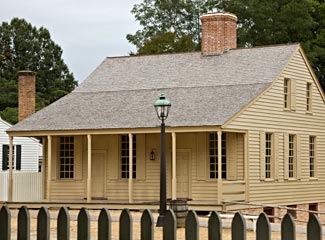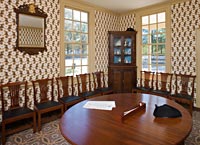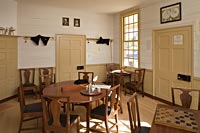Page content
R. Charlton's Coffeehouse

- Proximity to Capitol attracted elite patrons
- Victorian house built on coffeehouse foundation, later relocated
- Excavation informs restoration
- Porch scene of Stamp Act protest
- Reconstructed coffeehouse will serve coffee, chocolate
R. Charlton's Coffeehouse stood just a few steps from the colonial Capitol, its convenient location making it a popular stop for Williamsburg elite. Around tables that held steaming cups of coffee and chocolate, gentlemen and politicians met to make deals and strengthen connections.
Before restoration of the 18th-century coffeehouse could begin, an ancient structure from another era had to be removed - the lot where the coffeehouse stood had become the address of an 1890 Victorian home. Historic in its own right, the Cary Peyton Armistead house was preserved and moved to a new location on Henry Street.

Archaeological excavation of the foundation told the story of a building one and a half stories tall and 35 feet square, with a single, central chimney punctured with seven fireplaces. Food probably was prepared in the cellar and carried to customers upstairs. Artifacts recovered from the site, like the hand from a display skeleton and assaying crucibles with traces of precious metals, suggest an educated clientele. A gentry establishment that permitted no women, its sequestered rooms provided a place to conduct confidential business, or to host exclusive gatherings.

Perhaps more important to history than these private salons was the front porch, a simple shelter spanning the building's face. Here, Williamsburg's objection to England's Stamp Tax manifested as a vicious mob. The story goes that George Mercer, a stamp agent just sent from England, was chased down Duke of Gloucester Street by an angry crowd which protested the tax. It was on the porch of R. Charlton's Coffeehouse where Mercer took refuge, protected by no less a person than Governor Fauquier.
Reconstruction of the site began in 2008 with a generous gift from Deborah and Forrest Mars. A team of researchers, curators, tradespeople and builders completed the restoration in November 2009. In keeping with its legacy, R. Charlton's Coffeehouse serves samples of coffee and chocolate to guests.
Learn more:
- Learn more about 18th-century coffeehouses in the Colonial Williamsburg journal
- Read about the Coffeehouse Reconstruction in the Autumn 2008 Colonial Williamsburg journal.
- Read about the Stamp Act
- View videos of the Coffeehouse Reconstruction
- Coffeehouse blog